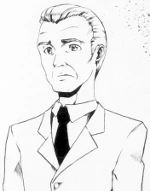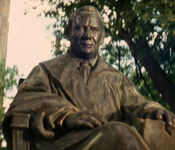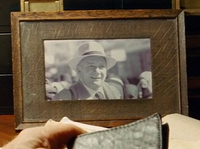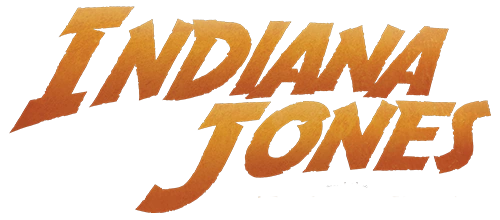- "You know Marcus, he got lost once in his own museum."
- ―Indiana Jones to Henry Jones, Sr.[src]
Doctor Marcus Brody was a British-born archaeologist, historian and lecturer who was a close friend to the Jones family, first through Henry Jones, with whom Brody attended Oxford, and then later through Henry's son Indiana Jones.
As a curator for several prominent museums on the east coast of the United States of America, Brody became a frequent patron of Indiana Jones. After his job as curator of the National Museum, he became Dean of Students at Marshall College, a position that he held for much of World War II before stepping down.
Biography[]
Early life[]
Marcus Brody was born in 1878[2] into a wealthy British family and grew up in London, England.[4] He had at least one sibling.[6] Marcus shared his forename with a cat that belonged to his father.[7]
In college, Brody studied at Oxford University, where he became fast friends with fellow student Henry Walton Jones, Senior[2] and both becoming members of the University Club;[8] as well as traveling to the United States to attend Princeton,[9] where he earned a bantam-weight boxing title around 1906.[2] Written correspondence from Brody the year prior would assist Henry Jones's 1906 travels through Europe to discover the Holy Grail. Brody directed Jones, by then a professor, to an abbey in Brittany, France containing a text which treated the Grail as a genuine historical artifact.[10]

Brody in 1913.
After graduation, Brody lectured at various universities and participated in minor archaeological digs. It was while teaching a class on Nordic mythology at a Midwestern university that Brody met Elizabeth,[11] the woman who would become his wife and inspire his study of Nordic heritage in the Americas.[12] Brody was able to witness Henry Jones's son Indiana grow up, and in 1913, he allowed the younger Jones to accompany him on an expedition to Egypt, where they recovered the Ring of Osiris. By that time, Brody had become assistant curator of the National Museum, which he dedicated himself to after his wife died of pneumonia.[2]
Whenever Indiana visited New York, he'd take the opportunity to visit Brody at the museum and the pair would view the displays together.[13] After the Joneses had the confrontation which led to their years-long estrangement,[14] Brody maintained his friendship with the both of them.[5]
In the United Kingdom in July 1920, Brody helped Henry, who was in the country researching the Arthurian collections of the British Museum and the Bodleian Library. He introduced the professor to several scholars supportive of Jones's work, including a Jesuit named Brother Matthius. The next day the two men left for Wales to make further investigations. A little under two weeks later, in the village of Mochdref, Jones got drunk while enticing Celtic legends about the Grail out of the locals at the Purple Dragon and arrested. On his way to the jail, Brody got lost and it took him most of the next morning to find his way there to pay Jones's fine.[10]
In 1922, Brody — representing the National Museum — contacted Indiana Jones who was then a student, to inform him that he was interested in his services, and asked Indy to give him a call the next time he was in the States.[15] After Jones acquired his Ph.D in 1925, Brody helped him secure a teaching job at London University.[3] When Jones was involved in a near-fatal plane crash in South America in 1926 that left him comatose for almost a month and took the lives of his new bride Deirdre and explorer Percy Harrison Fawcett, Brody was on hand to break the news of his wife's passing after Jones awoke.[12]
Years of adventure[]
In 1929, Indiana assisted Brody in a search for his missing brother-in-law, Hans Beitelheimer.[16]

Brody, after an encounter with Belloq in 1930.
In 1930 Brody sent a letter to Henry Jones about the discovery of the chronicles of Saint Anselm[10] and in the winter of that year, Brody and Indiana Jones were invited by the Swedish government to help excavate the Temple of Old Uppsala. Due to heavy snow, Brody stayed at the hotel in Uppsala while Jones explored the ruins with Theresa Lawrence. After Lawrence had left with the main treasure, a ring, Brody reluctantly agreed to Jones' request to recover the item from the British Museum. In London, Brody was robbed by René Belloq, who took the real treasure, a scroll that Jones had found. Jones and Lawrence managed to prevent Belloq from selling the scroll in Marrakesh to the Nazis, and then Brody and Jones returned to America from London, after Jones stole the ring back.[17]
In the late spring or early summer of 1931, Brody, upset about the theft of one of the Wohat Statues from the New York Museum of History, had brought the museum's security chief, Ballantine Gruber, to Barnett College to meet with Indiana Jones, who was better suited to tracking down the stolen crocodile statue. Jones realized that the statues were a clue to the Invincible Ruby of Ali Bey, and after Brody received a telegram about the theft of another statue in Barcelona, sent Jones after the stolen statues and the ruby.[18]
That year, Brody's work had led him to a position as Director of Special Acquisitions at the American Museum of Natural History in New York City.[19]
In 1933, Brody visited Indiana Jones in Princeton to tell him that the Voynich Manuscript had been stolen.[19] In 1934 he got marooned on the Triangle Islands.[20]
In 1936, he accompanied Jones to Tibet to track down a piece of the key held by an acquaintance, Francis Beresford-Hope. Escaping from a cave explosion, he and Jones met with Alex Beresford-Hope, who joined them to help prevent the Nazis from using the key. In Shanghai, Brody remained behind, cautious about the dangerous power represented by the ancient key, while Jones and Beresford-Hope journeyed toward Siberia. Changing his mind, Brody set after them on a whaling ship, and rescued Jones and treasure hunter Janice Le Roi from being stranded at sea. Reaching the Siberian coast with copies of the map, Brody rode on a dogsled with Jones over an ice bridge which collapsed behind them. Catching up with Friedrich von Hassell and his Nazi agents, they fell into a chasm, where Brody was captured by the Nazis and taken to the Tomb of the Gods, where Brody was nearly forced to open the tomb after Beresford-Hope was killed for refusing to do so. When voices in the tomb possessed several of the agents, starting a massacre, Brody was saved by Jones and Le Roi. Giving his satchel of dynamite to Jones, Brody waited in the antechamber while Jones chased von Hassell into the main vault. After Jones had dynamited the building, Brody agreed with the decision, since some knowledge was best left unknown.[21]

Marcus Brody, 1936.
By this time, Brody had become curator of the National Museum, and it was in this role that he helped arrange Indiana Jones' expedition to recover the Ark of the Covenant for the U.S. government, negotiating with military intelligence agents Musgrove and Eaton. When the Ark was recovered by Jones and Marion Ravenwood, Brody went to Washington DC, where they were paid, but informed that the Ark would not be going to the Museum. They were told that the Ark was to be researched by the government's own men instead. In reality, however, the Biblical relic was secreted away and hidden in a government warehouse.[1]
Later that year, when Jones had taken his "Archaeology 223" students to a dig at a Hopi cave in Arizona, Jones called into Brody with his suspicions about the cave's closure being a front. Brody, in turn, relayed his concern about Ravenwood's publicity tactics in her new role as the public relations officer for the museum.[22] Some weeks later, Brody joined Jones and Ravenwood on a mission to Wales, where they helped delve the secrets of Lucifer's Chamber, against Brody's former classmate, Austin Coleridge.[23]
In 1938, Indy acquired the Cross of Coronado for Brody's museum. Shortly thereafter, Indy learned that his father had disappeared while researching the Holy Grail for wealthy American industrialist Walter Donovan. Upon hearing the news, Brody insisted on accompanying the younger Jones to Venice to help search for his old friend. In Venice, an encounter with the Brotherhood of the Cruciform Sword sent Indy off to rescue his father, held captive by the Nazis in Castle Brunwald while Brody, after recovering from an attack by Kazim, traveled to Iskenderun to commission Sallah el-Kahir's assistance in obtaining the Grail. There, Brody found himself the victim of Nazi kidnapping. The Nazis used the Grail Diary pages in Brody's possession to trace the Grail to the Republic of Hatay, where Brody was rescued by Indy, Sallah, and the newly freed Henry Jones, Sr. Marcus joined the team for one final confrontation with the Nazis—and their secret ally, Donovan—at the Grail Temple. The result saw Donovan's death, the finding and eventual loss of the Grail, and the destruction of the temple.[5]
In 1939, Brody asked Indy to keep an eye out for several treasures on his search for the Staff of Kings.[15] Later that year, Brody retired as curator of the National Museum in order to become Dean of Students at Marshall College, a position he held until 1944.[2] In 1947, Brody accompanied Indiana Jones to Berlin to search for the Philosopher's Stone.[24]
Death and legacy[]
- "You should be the one here, Marcus."
- ―Charles Stanforth heading to Jones's wedding.[src]

Statue of Brody.
Brody died in 1952, around the age of seventy-four.[2] His loss deeply affected Indiana Jones. As a form of tribute, Jones pushed hard for the Marshall faculty and staff to approve the erection of a bronze statue bearing Brody's likeness.[25]
The statue was already complete and installed on the Marshall campus by 1957; however a car of KGB agents, while pursuing Jones and Mutt Williams, crashed into the statue base and its head broke and fell on the car, smashing through the windshield and winding up in one KGB agent's lap.[25] Indiana remarked that even in death, his friend had his back.[26]
In addition to the statue, a portrait of Brody was placed on one of the college walls[25] When the minister of the wedding between Jones and Marion Ravenwood forgot his Bible, Brody's friend and successor Dean Charles Stanforth fetched the generations-old Brody family Bible that Marcus had left to the college in his will so the ceremony could continue.[26][27]
Personality and traits[]
- "How a man who can smell out a rare manuscript with the instinct of a bloodhound can get lost in a village of twenty houses is a mystery known only to the creator."
- ―Henry Jones' grail diary[src]
As a younger man, Marcus Brody was more eager for archaeological fieldwork, but by 1936, he had become more the academician, leaving the exploration of sites to his friend, Indiana Jones.[1] In his prime days, Brody enjoyed excitement and adventure, but by his later years, had become too old for treasure hunting.[28]
He spoke English and ancient Greek. Though he claimed to be a vegetarian to the street vendors of Iskenderun, it may have been an attempt to deny the peddler a chance to sell him chickens as he also declined an offer of water as "fish make love in it". Brody was of the Christian faith, performing the sign of the cross when he witnessed the Holy Grail heal Henry Jones, Sr. and had considered the quest for the relic as the search for the divine within every man.[5]
As museum curator, Brody tended to keep to himself to his offices as he found he'd get distracted by the archaeological pieces on display.[13] He even got lost once in the archives of his own museum.[2] Out of his element, Brody could become utterly helpless in the field which contributed to his capture by Nazi agents in Iskenderun. Unable to pick up on the hints from Sallah to flee from the sinister pair of men pretending to be acting on behalf of a museum that didn't exist, Brody didn't try to escape until the exasperated Sallah sucker-punched the Nazis and implored him to run.[5]
Behind the scenes[]

The photo of Marcus on Indy's desk.
Marcus Brody was portrayed by the late Denholm Elliott in Raiders of the Lost Ark[1] and Indiana Jones and the Last Crusade.[5] Elliot passed away in 1992, before the filming of the then untitled Indiana Jones and the Kingdom of the Crystal Skull, so both Steven Spielberg and George Lucas decided to retire the character. In Crystal Skull, the character of Charles Stanforth fulfills a similar role to Brody,[25] who is mentioned to have died in 1952 in Indiana Jones: The Ultimate Guide.[2]
During Raiders pre-production, Lucasfilm Ltd. researcher Deborah Fine advised that the character should be referred to as "Marcus Brody" or "Marcus" onscreen to avoid confusion with an existing museum administrator.[29]
According to director Steven Spielberg, no auditions took place for the role of Brody in Raiders and Elliott was cast as Spielberg was a fan of the actor. In Spielberg's words, Brody is "the voice of reason, the voice of caution", as well as being more paranoid than Indiana himself.[30] As with Alfred Molina (Satipo), Elliott was one of the last actors cast in the film.[29]
In Raiders, Brody was a rather serious character.[1] In Last Crusade, however, Brody became less so with Indy saying "he got lost once in his own museum", though it should be noted in both of his appearances, he is clearly quite astute at history and archaeology, meaning his lighter portrayal in Last Crusade may have just been a case of him being a fish out of water.[5]
The decision to kill off Marcus Brody for what became Indiana Jones and the Kingdom of the Crystal Skull was put forward during the development of the film in the 1990s. In Jeb Stuart's script Indiana Jones and the Saucermen from Mars, Indy mentions to his father that it would have been great if Marcus was there with them.[31] In Frank Darabont's script Indiana Jones and the City of the Gods, Indy visits the National Museum one night after being fired from his job at Marshall College and sees Brody's memorial statue.[32] The idea of a memorial statue was utilized in Crystal Skull.[25] The production erected the statue, based on Elliott's likeness, on the quad of the Yale University.[29]
In LEGO Indiana Jones: The Original Adventures, Brody's role in both Raiders and Last Crusade is largely the same as the films, although in the latter his kidnapping in Iskederun is omitted and he is never taken as a hostage inside Vogel's Mark VII Tank.[33] In the sequel, Brody's role in Raiders and Last Crusade is relatively minor, although he is also present during the events of Indiana Jones and the Temple of Doom. He is seen to be still alive during the events of Crystal Skull despite the statue erected in his memory being present at Marshall College. The portable versions of the game, however, indirectly mention his passing.[34]
The design document for "Indiana Jones 2007",[35] an early version of the Indiana Jones and the Staff of Kings video game by LucasArts,[36] indicates that Marcus was considered for a role as a recurring character in the story, available for players to send correspondence to to receive hints, tips and provide context.[35] Though this concept was dropped by the finished game, in the PlayStation Portable version of Staff of Kings, an off-screen Brody actively sends telegrams to Indy requesting that he find certain artifacts for the National Museum. In the Wii/PS2 version, Indiana Jones notes on several of artifacts found in the game that Brody would be interested in the pieces.[15]
Appearances[]
Sources[]
 Raiders of the Lost Ark trading cards (Card: Outlining The Quest)
Raiders of the Lost Ark trading cards (Card: Outlining The Quest)- The Adventures of Indiana Jones
- The Golden Goddess
- Crystal Death
- Grail Diary
- The Byzantine Crusader
- From Star Wars To Indiana Jones - The Best of the Lucasfilm Archives
- The World of Indiana Jones
- Raiders of the Lost Ark Sourcebook
- Indiana Jones and the Sky Pirates and Other Tales
- Indiana Jones and the Infernal Machine: Prima's Official Strategy Guide
Raiders of the Lost Ark: Artifact for teacher on IndianaJones.com (backup link on Archive.org)
The Last Crusade: Get a clue on IndianaJones.com (backup link on Archive.org)
Around the World with Indiana Jones on IndianaJones.com (backup link on Archive.org)
Indiana Jones' Marshall College entry on IndianaJones.com (backup link on Archive.org)
- Indiana Jones and the Emperor's Tomb: 1935 Journal
 Indiana Jones Movie Photo Cards (Card: In Search Of... Himself)
Indiana Jones Movie Photo Cards (Card: In Search Of... Himself)- Indiana Jones: The Ultimate Guide
- "You Call This Archeology?" - Indiana Jones: The Official Magazine 3
- "The Thrill of the Chase!" - Indiana Jones: The Official Magazine 4
- "Indy's Top 10 Funniest Moments" - Indiana Jones: The Official Magazine 6
- The Lost Journal of Indiana Jones
- The Indiana Jones Handbook
- The Complete Making of Indiana Jones
- Top Trumps: Indiana Jones
- Grail Diary (prop replica)
 Inside the World of Indiana Jones on Lucasfilm.com (backup link on Archive.org)
Inside the World of Indiana Jones on Lucasfilm.com (backup link on Archive.org)- Indiana Jones Cryptic
 40 Great Indiana Jones Quotes on Lucasfilm.com (backup link on Archive.org)
40 Great Indiana Jones Quotes on Lucasfilm.com (backup link on Archive.org) 8 New Discoveries in the Indiana Jones and the Great Circle Trailer on Lucasfilm.com (backup link on Archive.org)
8 New Discoveries in the Indiana Jones and the Great Circle Trailer on Lucasfilm.com (backup link on Archive.org) Lucasfilm Games Rewind: Indiana Jones and the Fate of Atlantis on Lucasfilm.com (backup link on Archive.org)
Lucasfilm Games Rewind: Indiana Jones and the Fate of Atlantis on Lucasfilm.com (backup link on Archive.org)
